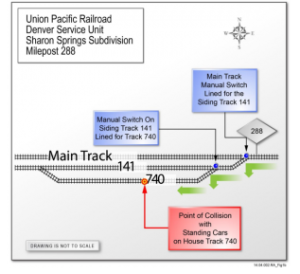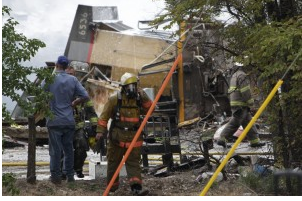By James Bell
 HAYS -The National Transportation Safety Board has closed the investigation into a train derailment in Hays on July 16, 2013, that caused an estimated $1.4 million in damages. The investigation found the accident was caused by human error, but could have been avoided if recommendations from the NTSB had been adopted.
HAYS -The National Transportation Safety Board has closed the investigation into a train derailment in Hays on July 16, 2013, that caused an estimated $1.4 million in damages. The investigation found the accident was caused by human error, but could have been avoided if recommendations from the NTSB had been adopted.
After securing cars on a side track, a switch had been incorrectly set, causing the next train to move to the side track, derailing the train and causing a massive fire in the area. Screen Shot 2015-10-09 at 3.33.52 PM
“The National Transportation Safety Board determines that the probable cause of the accident was the failure of the brakeman of train LDG89 15 (the train that was parked on the side track) to return a main track switch to the normal position after the crew had secured the train on a siding track. Contributing to the accident was the inability of the crew of train MSIDV 16 (the train that was in movement) to determine the position of the main track switch in nonsignaled territory,” the report said.
Similar incidents in the past, evaluated by the NTSB, have resulted in recommendations that automated systems be installed to help mitigate the risk of a singe point of failure.
“All of these accidents resemble the accident at Hays, Kansas. In each instance, a crewmember failed to return a main track switch to the normal position. More significantly, these accidents occurred in nonsignaled territory where there is only local indication of switch alignment. The brakeman of LDG89 15 erred when he failed to return the main track switch to the normal position before he and the rest of the crew departed the accident area,” the report said.
While the NTSB has made recommendations that would have stopped the accident from occurring, those recommendations have been rebuffed by the Federal Railroad Administration as being to expensive.
“A single errant act on the part of an individual that can lead to an accident is a single point failure in system safety analysis. If the single point failure is significant and the potential consequences are severe, the risk should be mitigated by additional layers of protection,” the report said.
Three incidents prior to the Hays derailment were cited in the report to be caused by similar situations.
